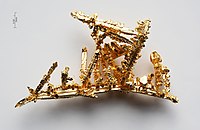
Photo from wikipedia
To improve the sensitivity of the electrochemical DNA (E-DNA) sensors is extremely necessary for the diagnosis and early detection of cancer. Among the factors that affect the sensitivity of the… Click to show full abstract
To improve the sensitivity of the electrochemical DNA (E-DNA) sensors is extremely necessary for the diagnosis and early detection of cancer. Among the factors that affect the sensitivity of the sensors, the most important is the structure of the probe on the electrode surface. Probes may have different structures, but have only two detection mechanisms, that is signal-off and signal-on. Many reports suggest that the detection effect of signal-on probe is better than signal-off probe. To verify this, we have conducted experiments on two probes that have similar sequences which are complementary with target and typical for two detection mechanisms of the sensor, i.e., probe has stem-loop structure according to the signal-off mechanism, and probe has hairpin structure according to the signal-on mechanism in the same experimental conditions. The results showed that the limit of detection (LOD) of sensor with stem-loop probe is 200pM, meanwhile hairpin probe sensor has LOD of 25 pM.
Journal Title: International Journal of Nanotechnology
Year Published: 2018
Link to full text (if available)
Share on Social Media: Sign Up to like & get
recommendations!